DeLUXE EDITION
Once purchased, you will receive an email with several delightful and carefully designed scores and files in pdf:
- Front and back covers of the score.
- Useful historical and musical contextualization (Spanish, French and English).
- Music (score and particellas).
- This edition also include some superb figures related to the score in question, some of which unpublished until now.
This is the list:
S.R.1: Jules CRESSONNOIS. La Chanson du Printemps (Voix/Tsx/Pno)
Figure 1: Typical Military band concert in the park.
Figure 2: Front cover of the original edition.
Figure 3: Sax’s instrumental exhibition in presence of Abd el-Kader.
Figure 4: Comte Adolphe de Pontécoulant, ca. 1860.
Figure 5: Adolphe Sax, ca. 1860.
Figure 6: Parade of regiment of Cuirassiers, ca. 1894.
S.R.2: Antonio PASCULLI. Concerto sopra motivi dell'opera La Favorita (Ssx/Pno, from Ob/Pno)
Figure 1: Antonio Pasculli (1881).
Figure 2: Palermo, ca. 1875, Pasculli’s birthplace.
Figure 3: Gaetano Donizetti, ca. 1843.
Figure 4: Aerial view of Cádiz (1862), where La Favorita is set (more precisely, at the beach of Isla de León [nowadays, San Fernando]) during Act I, Scene 2 (Year 1340). That beach would be a little far away at the right of the engraving.
Figure 5: Photograph taken (ca. 1880) from the similar point of view (Castillo de San Sebastián) of figure 4.
Figure 6: Isla de León’s beach location.
S.R.3: ALI-BEN-SOU-ALLE: Doux Souvenir. Schotish [sic] (Ssx or Tsx/Pno)
Figure 1: Main sketch of Soualle’s patent of September 22nd, 1860.
Figure 2: Park amusement in the park around a band playing a polka.
Figure 3: Detail of the figure 2 (band and dancing people).
S.R.4: ALI-BEN-SOU-ALLE: Adieu à la Nouvelle-Zélande (Asx or Bsx/Pno)
Figure 1: Soualle (with his turcophone) dressed in Arab style.
Figure 2: Louis Jullien, ca. 1846.
Figure 3: Typical promenade concert and bandstand (Hastings, UK).
S.R.5: ALI-BEN-SOU-ALLE: Le Trouvère (Asx/Pno)
Figure 1: Map of Soualle’s travels around the world. (Continued line: surely; discontinued line: possibly).
Figure 2: South Africa, Cape of Good Hope, ca. 1880.
Figure 3: Sidney, Australia, ca. 1890.
Figure 4 and 5: Governor’s house in Batavia (Jakarta) and sumptuous tent in Deel (India), both ca. 1875, where Soualle may have entertain its hosts.
Figure 6: Auckland (New Zeeland) harbor, ca. 1875.
Figure 7: Shanghai, China, ca. 1875
Figure 8: Hobart, Tasmania, front Mount Wellington, ca. 1890.
S.R.6: ALI-BEN-SOU-ALLE: Don Juan (Asx or Bsx/Pno)
Figure 1: Soualle (with his turcophone) dressed in Arab style.
S.R.7: ALI-BEN-SOU-ALLE: Caprice (Asx or Bsx/Pno)
Figure 1: Jullien leading a concert in the Covent Garden, London (1846).
Figure 2: Louis Jullien (1812-1860).
Figure 3: Jullien’s detail of figure 1.
Figure 4: Soualle’s Arab ‘logo’ letters from one of his scores.
Figure 5: Example of ‘monster’ concert as usually Jullien did. (Not Jullien conducting).
Figure 6: Soualle’s noted performance with the Corno-Musa (saxophone?) in Jullien’s advertise group in London.
S.R.8: Jules DEMERSSEMAN: Deuxième Solo (Ssx/Pno)
Figure 1: Jules Demersseman (1833-1866).
Figure 2: Original front cover of the score from Sax’s publishing house.
Figure 3: Brussels’ Grand-Place view (1844).
Figure 4: François Nazaire Beeckman (1822-1900).
Figure 5: Beeckman’s Methode (1874).
Figure 6: Soprano saxophone player from Beeckman’s Methode (1874).
S.R.9: Hyacinthe KLOSÉ: Duettino Concertante (2Cl/Pno, or Cl/Asx/Pno)
Figure 1: Hyacinthe Klosé (1808-1880).
Figure 2: Auguste Buffet, jeune (1816-1884).
Figure 3: Klosé’s clarinet Méthode (1843).
Figure 4: Klosé’s saxophone Méthode (1866).
Figure 5: Sketches of Buffet’s French Patent of December 15th,1843.
Figure 6: Klosé’s thirteen key clarinet and clarinet with movable rigs from a fingering chart of his Méthode.
S.R.10: Louis MAYEUR: La Favorite (Ssx/Tsx/Pno)
Figure 1: Seville (1843), where La Favorita is set (more precisely at Alcázar –gardens and salon-, very near of the Cathedral) during Acts II and III (Year 1340).
Figure 2: Seville (ca. 1880) view from a riverside of Guadalquivir with the Torre del Oro and Cathedral.
Figure 3: La Giralda or bell tower of the Seville Cathedral.
Figure 4: Band of music of the First Regiment of Grenadiers (ca. 1863)
Figure 5: Detail of the saxophone section of the band of previous figure.
Figure 6: Front cover of the original edition
S.R.11: Ambroise THOMAS: Two songs of old Peru (Asx or Ssx or Tsx/Tsx/Bsx)
Figure 1: Ambroise Thomas (1811-1894), ca. 1894.
Figure 2: Ambroise Thomas’ signature.
Figure 3: Exam of contrabass class headed by Ambroise Thomas (ca. 1890).
Figure 4: Paris Conservatory entrance (1847).
Figure 5: Daniel Auber, Principal of the Conservatory before Thomas.
Figure 6: Oscar Comettant (1819-1898).
Figure 7: Conservatory concert hall (1843).
Figure 8: Opera ‘Le Peletier’ main entrance (1844).
S.R.12: Hyacinthe KLOSÉ: Solo (Ssx or Asx/Pno)
Figure 1: Hyacinthe-Eleonor Klosé (1808-1880).
Figure 2: Adolphe Sax (1814-1894).
Figure 3: Front cover of the original Sax’s edition.
Figure 4: Program of a concert in Adolphe Sax’s salon.
Figure 5: Park and kiosk with its band of music in Enghien, France. (1848).
Figure 6: Detail of the kiosk of the figure 5.
Figure 7: A military band leading a religious procession (1868).
Figure 8: Detail of the of previous figure.
Figure 9: Republican Military Guard Band playing in the Jardin des Plants (ca. 1904).
Figure 10: Detail of the clarinet and saxophone sections of the previous figure.
S.R.13: Louis MAYEUR: Lucrèce Borgia (Asx/Pno)
Figure 1: Saxophone player.
Figure 2: Louis Mayeur’s signature.
Figure 3: Uniforms of the bands that take part in the contest of 1867 according to to the newspaper. From left to right, Gendarmeire de la Garde Française, French Guides, Grand Duchy of Baden, Bavaria, Prussia, Austria, Spain, Russia and Belgium. (Maybe, the man in the back left is holding a soprano saxophone).
Figure 4: First page of Millereau’s patent (“système Millereau-Mayeur”) of October 1st, 1887. (Basically, a bass semitone, from B to B♭).
Figure 5: Sketch of Millereau’s patent (“système Millereau-Mayeur”).
Figure 6: Band contest in Vimoutiers, France (1869).
Figure 7: Detail of a waiting band of the previous figure.
Figure 8: Night band concert in Baden, [today] Germany (1868).
Figure 9: Detail of the kiosk –and its musicians- of the previous figure.
S.R.14: Louis MAYEUR: Lucia di Lammermoor (Asx/Pno)
Figure 1: External musicians of the Opera (Sax’s band, mainly brass).
Figure 2: Jardin d’acclimatation, ca. 1880.
Figure 3: Main entrance of Jardin d’acclimatation, ca. 1900.
Figure 4: Sax’s instrumental presentation in his Salon, rue Saint Georges 50, Paris.
Figure 5: Detail of the performers of the previous figure. (Mayeur, first on the right holding a saxophone?).
S.R.15: Louis MAYEUR: Don Juan (Asx/Pno)
Figure 1: Front cover of the original edition (1872) published by Adolphe Sax’s company.
Figure 2: François-Auguste Gevaert (ca. 1864).
Figure 3: Gevaert’s signature.
S.R.16: Louis MAYEUR: La Favorite (Tsx/Pno)
Figure 1: Concert in the kiosk of Royal Park of Brussels with Sax’s instruments.
Figure 2: Detail of the musicians of the previous figure.
Figure 3: American military music group with a soldier holding a saxophone (ca. 1865). (First known photo of a saxophone).
Figure 4: Front cover of the original edition.
Figure 5: Detail of the soldier
holding a saxophone of figure 3.
S.R.17: Louis MAYEUR: Le Trouvère (Asx/Tsx/Pno)
Figure 1: Zouaves military band (of the Imperial Guard) with several saxophone players (1867).
Figure 2: Bon Marché department stores (1880), where Mayeur played with his group to enliven up the shopping.
S.R.18: Louis MAYEUR: Rigoletto (Asx/Pno)
Figure 1: Edward A. Lefebre (1835-1911).
Figure 2: : Lefebre’s signature.
Figure 3: (Old) New York Academy of Music, ca. 1870 (4th Street and Irving Place).
Figure 4: (Old) Brooklyn Academy of Music, ca. 1862 (176, Montage Street).
Figure 5: First Gilmore’s advertisement concert in Brooklyn.
Figure 6: American band amenizing a sunny Saturday afternoon in the ground of the White House.
Figure 7: Detail of the band of the previous figure.
Figure 8: Gilmore’s band, ca. 1884.
Figure 9: Drawing of Gilmore’s band, ca. 1885.
Figure 1: Typical Military band concert in the park.
Figure 2: Front cover of the original edition.
Figure 3: Sax’s instrumental exhibition in presence of Abd el-Kader.
Figure 4: Comte Adolphe de Pontécoulant, ca. 1860.
Figure 5: Adolphe Sax, ca. 1860.
Figure 6: Parade of regiment of Cuirassiers, ca. 1894.
S.R.2: Antonio PASCULLI. Concerto sopra motivi dell'opera La Favorita (Ssx/Pno, from Ob/Pno)
Figure 1: Antonio Pasculli (1881).
Figure 2: Palermo, ca. 1875, Pasculli’s birthplace.
Figure 3: Gaetano Donizetti, ca. 1843.
Figure 4: Aerial view of Cádiz (1862), where La Favorita is set (more precisely, at the beach of Isla de León [nowadays, San Fernando]) during Act I, Scene 2 (Year 1340). That beach would be a little far away at the right of the engraving.
Figure 5: Photograph taken (ca. 1880) from the similar point of view (Castillo de San Sebastián) of figure 4.
Figure 6: Isla de León’s beach location.
S.R.3: ALI-BEN-SOU-ALLE: Doux Souvenir. Schotish [sic] (Ssx or Tsx/Pno)
Figure 1: Main sketch of Soualle’s patent of September 22nd, 1860.
Figure 2: Park amusement in the park around a band playing a polka.
Figure 3: Detail of the figure 2 (band and dancing people).
S.R.4: ALI-BEN-SOU-ALLE: Adieu à la Nouvelle-Zélande (Asx or Bsx/Pno)
Figure 1: Soualle (with his turcophone) dressed in Arab style.
Figure 2: Louis Jullien, ca. 1846.
Figure 3: Typical promenade concert and bandstand (Hastings, UK).
S.R.5: ALI-BEN-SOU-ALLE: Le Trouvère (Asx/Pno)
Figure 1: Map of Soualle’s travels around the world. (Continued line: surely; discontinued line: possibly).
Figure 2: South Africa, Cape of Good Hope, ca. 1880.
Figure 3: Sidney, Australia, ca. 1890.
Figure 4 and 5: Governor’s house in Batavia (Jakarta) and sumptuous tent in Deel (India), both ca. 1875, where Soualle may have entertain its hosts.
Figure 6: Auckland (New Zeeland) harbor, ca. 1875.
Figure 7: Shanghai, China, ca. 1875
Figure 8: Hobart, Tasmania, front Mount Wellington, ca. 1890.
S.R.6: ALI-BEN-SOU-ALLE: Don Juan (Asx or Bsx/Pno)
Figure 1: Soualle (with his turcophone) dressed in Arab style.
S.R.7: ALI-BEN-SOU-ALLE: Caprice (Asx or Bsx/Pno)
Figure 1: Jullien leading a concert in the Covent Garden, London (1846).
Figure 2: Louis Jullien (1812-1860).
Figure 3: Jullien’s detail of figure 1.
Figure 4: Soualle’s Arab ‘logo’ letters from one of his scores.
Figure 5: Example of ‘monster’ concert as usually Jullien did. (Not Jullien conducting).
Figure 6: Soualle’s noted performance with the Corno-Musa (saxophone?) in Jullien’s advertise group in London.
S.R.8: Jules DEMERSSEMAN: Deuxième Solo (Ssx/Pno)
Figure 1: Jules Demersseman (1833-1866).
Figure 2: Original front cover of the score from Sax’s publishing house.
Figure 3: Brussels’ Grand-Place view (1844).
Figure 4: François Nazaire Beeckman (1822-1900).
Figure 5: Beeckman’s Methode (1874).
Figure 6: Soprano saxophone player from Beeckman’s Methode (1874).
S.R.9: Hyacinthe KLOSÉ: Duettino Concertante (2Cl/Pno, or Cl/Asx/Pno)
Figure 1: Hyacinthe Klosé (1808-1880).
Figure 2: Auguste Buffet, jeune (1816-1884).
Figure 3: Klosé’s clarinet Méthode (1843).
Figure 4: Klosé’s saxophone Méthode (1866).
Figure 5: Sketches of Buffet’s French Patent of December 15th,1843.
Figure 6: Klosé’s thirteen key clarinet and clarinet with movable rigs from a fingering chart of his Méthode.
S.R.10: Louis MAYEUR: La Favorite (Ssx/Tsx/Pno)
Figure 1: Seville (1843), where La Favorita is set (more precisely at Alcázar –gardens and salon-, very near of the Cathedral) during Acts II and III (Year 1340).
Figure 2: Seville (ca. 1880) view from a riverside of Guadalquivir with the Torre del Oro and Cathedral.
Figure 3: La Giralda or bell tower of the Seville Cathedral.
Figure 4: Band of music of the First Regiment of Grenadiers (ca. 1863)
Figure 5: Detail of the saxophone section of the band of previous figure.
Figure 6: Front cover of the original edition
S.R.11: Ambroise THOMAS: Two songs of old Peru (Asx or Ssx or Tsx/Tsx/Bsx)
Figure 1: Ambroise Thomas (1811-1894), ca. 1894.
Figure 2: Ambroise Thomas’ signature.
Figure 3: Exam of contrabass class headed by Ambroise Thomas (ca. 1890).
Figure 4: Paris Conservatory entrance (1847).
Figure 5: Daniel Auber, Principal of the Conservatory before Thomas.
Figure 6: Oscar Comettant (1819-1898).
Figure 7: Conservatory concert hall (1843).
Figure 8: Opera ‘Le Peletier’ main entrance (1844).
S.R.12: Hyacinthe KLOSÉ: Solo (Ssx or Asx/Pno)
Figure 1: Hyacinthe-Eleonor Klosé (1808-1880).
Figure 2: Adolphe Sax (1814-1894).
Figure 3: Front cover of the original Sax’s edition.
Figure 4: Program of a concert in Adolphe Sax’s salon.
Figure 5: Park and kiosk with its band of music in Enghien, France. (1848).
Figure 6: Detail of the kiosk of the figure 5.
Figure 7: A military band leading a religious procession (1868).
Figure 8: Detail of the of previous figure.
Figure 9: Republican Military Guard Band playing in the Jardin des Plants (ca. 1904).
Figure 10: Detail of the clarinet and saxophone sections of the previous figure.
S.R.13: Louis MAYEUR: Lucrèce Borgia (Asx/Pno)
Figure 1: Saxophone player.
Figure 2: Louis Mayeur’s signature.
Figure 3: Uniforms of the bands that take part in the contest of 1867 according to to the newspaper. From left to right, Gendarmeire de la Garde Française, French Guides, Grand Duchy of Baden, Bavaria, Prussia, Austria, Spain, Russia and Belgium. (Maybe, the man in the back left is holding a soprano saxophone).
Figure 4: First page of Millereau’s patent (“système Millereau-Mayeur”) of October 1st, 1887. (Basically, a bass semitone, from B to B♭).
Figure 5: Sketch of Millereau’s patent (“système Millereau-Mayeur”).
Figure 6: Band contest in Vimoutiers, France (1869).
Figure 7: Detail of a waiting band of the previous figure.
Figure 8: Night band concert in Baden, [today] Germany (1868).
Figure 9: Detail of the kiosk –and its musicians- of the previous figure.
S.R.14: Louis MAYEUR: Lucia di Lammermoor (Asx/Pno)
Figure 1: External musicians of the Opera (Sax’s band, mainly brass).
Figure 2: Jardin d’acclimatation, ca. 1880.
Figure 3: Main entrance of Jardin d’acclimatation, ca. 1900.
Figure 4: Sax’s instrumental presentation in his Salon, rue Saint Georges 50, Paris.
Figure 5: Detail of the performers of the previous figure. (Mayeur, first on the right holding a saxophone?).
S.R.15: Louis MAYEUR: Don Juan (Asx/Pno)
Figure 1: Front cover of the original edition (1872) published by Adolphe Sax’s company.
Figure 2: François-Auguste Gevaert (ca. 1864).
Figure 3: Gevaert’s signature.
S.R.16: Louis MAYEUR: La Favorite (Tsx/Pno)
Figure 1: Concert in the kiosk of Royal Park of Brussels with Sax’s instruments.
Figure 2: Detail of the musicians of the previous figure.
Figure 3: American military music group with a soldier holding a saxophone (ca. 1865). (First known photo of a saxophone).
Figure 4: Front cover of the original edition.
Figure 5: Detail of the soldier
holding a saxophone of figure 3.
S.R.17: Louis MAYEUR: Le Trouvère (Asx/Tsx/Pno)
Figure 1: Zouaves military band (of the Imperial Guard) with several saxophone players (1867).
Figure 2: Bon Marché department stores (1880), where Mayeur played with his group to enliven up the shopping.
S.R.18: Louis MAYEUR: Rigoletto (Asx/Pno)
Figure 1: Edward A. Lefebre (1835-1911).
Figure 2: : Lefebre’s signature.
Figure 3: (Old) New York Academy of Music, ca. 1870 (4th Street and Irving Place).
Figure 4: (Old) Brooklyn Academy of Music, ca. 1862 (176, Montage Street).
Figure 5: First Gilmore’s advertisement concert in Brooklyn.
Figure 6: American band amenizing a sunny Saturday afternoon in the ground of the White House.
Figure 7: Detail of the band of the previous figure.
Figure 8: Gilmore’s band, ca. 1884.
Figure 9: Drawing of Gilmore’s band, ca. 1885.
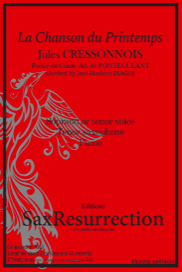
Price: €18
S.R.1: Jules CRESSONNOIS. La Chanson du Printemps (Soprano or tenor voice, Tenor saxophone and Piano).
Composed in 1863.
Longtime: about 2 minutes and 55 seconds.
Difficulty level (from 1 -easiest- to 14 -very difficult-): 5-6
Main technical and performance skills: expressive phrasing, singing reference and intonation.
Composed in 1863.
Longtime: about 2 minutes and 55 seconds.
Difficulty level (from 1 -easiest- to 14 -very difficult-): 5-6
Main technical and performance skills: expressive phrasing, singing reference and intonation.
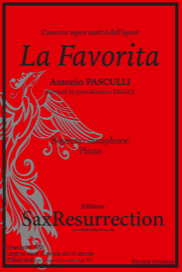
Price: €18
S.R.2: Antonio PASCULLI: Concerto sopra motivi dell'opera La Favorita (Soprano saxophone and Piano, from the original Ob/Pno).
Composed in 1879.
Longtime: about 13 minutes and 10 seconds.
Difficulty level (from 1 -easiest- to 14 -very difficult-): 14
Main technical and performance skills: brilliant technique, well-controlled breathing, circular breathing -if possible including articulations-, expressive phrasing, opera singing reference, intonation, tonguing and articulation accuracy, and physical and muscular endurance.
Composed in 1879.
Longtime: about 13 minutes and 10 seconds.
Difficulty level (from 1 -easiest- to 14 -very difficult-): 14
Main technical and performance skills: brilliant technique, well-controlled breathing, circular breathing -if possible including articulations-, expressive phrasing, opera singing reference, intonation, tonguing and articulation accuracy, and physical and muscular endurance.
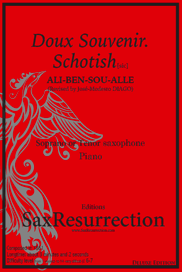
Price: €11
S.R.3: ALI-BEN-SOU-ALLE: Doux Souvenir. Schotish [sic] (Soprano or Tenor saxophone and Piano).
Composed in 1861.
Longtime: about 3 minutes and 2 seconds.
Difficulty level (from 1 -easiest- to 14 -very difficult-): 6-7
Main technical and performance skills: intonation and dance inspiration rhythm.
Composed in 1861.
Longtime: about 3 minutes and 2 seconds.
Difficulty level (from 1 -easiest- to 14 -very difficult-): 6-7
Main technical and performance skills: intonation and dance inspiration rhythm.
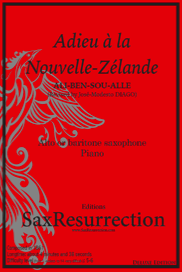
Price: €12
S.R.4: ALI-BEN-SOU-ALLE: Adieu à la Nouvelle-Zélande (Alto or baritone saxophone and Piano).
Composed in 1861.
Longtime: about 4 minutes and 38 seconds.
Difficulty level (from 1 -easiest- to 14 -very difficult-): 5-6.
Main technical and performance skills: intonation, expressive phrasing, dance inspiration rhythm, and varied dynamics.
Composed in 1861.
Longtime: about 4 minutes and 38 seconds.
Difficulty level (from 1 -easiest- to 14 -very difficult-): 5-6.
Main technical and performance skills: intonation, expressive phrasing, dance inspiration rhythm, and varied dynamics.
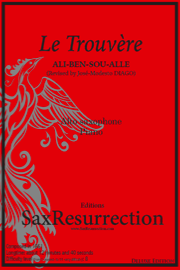
Price: €15
S.R.5: ALI-BEN-SOU-ALLE: Le Trouvère (Alto saxophone and Piano).
Composed in 1861.
Longtime: about 12 minutes and 40 seconds.
Difficulty level (from 1 -easiest- to 14 -very difficult-): 8
Main technical and performance skills:
Expressive phrasing. Intonation. Opera singing reference. Varied articulations and dynamics. Cadenza imagination.
Composed in 1861.
Longtime: about 12 minutes and 40 seconds.
Difficulty level (from 1 -easiest- to 14 -very difficult-): 8
Main technical and performance skills:
Expressive phrasing. Intonation. Opera singing reference. Varied articulations and dynamics. Cadenza imagination.
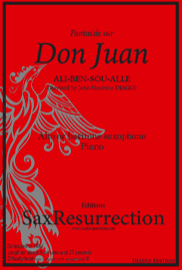
Price: €12
S.R.6: ALI-BEN-SOU-ALLE: Don Juan (Alto or baritone saxophone and Piano).
Composed in 1861.
Longtime: about 5 minutes and 27 seconds.
Difficulty level (from 1 -easiest- to 14 -very difficult-): 8
Main technical and performance skills: expressive phrasing, opera singing reference, intonation, varied articulations and dynamics, and ease and agility playing.
Composed in 1861.
Longtime: about 5 minutes and 27 seconds.
Difficulty level (from 1 -easiest- to 14 -very difficult-): 8
Main technical and performance skills: expressive phrasing, opera singing reference, intonation, varied articulations and dynamics, and ease and agility playing.
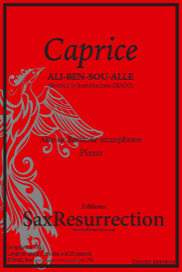
Price: €10
S.R.7: ALI-BEN-SOU-ALLE: Caprice (Alto or Baritone saxophone and Piano).
Composed in 1861.
Longtime: about 2 minutes and 26 seconds.
Difficulty level (from 1 -easiest- to 14 -very difficult-): 7-8
Main technical and performance skills: expressive phrasing, rhythm and beat accuracy, intonation and quick range changes.
Composed in 1861.
Longtime: about 2 minutes and 26 seconds.
Difficulty level (from 1 -easiest- to 14 -very difficult-): 7-8
Main technical and performance skills: expressive phrasing, rhythm and beat accuracy, intonation and quick range changes.
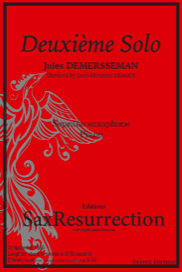
Price: €15
S.R.8: Jules DEMERSSEMAN: Deuxième Solo (Soprano saxophone and Piano).
Composed in 1866.
Longtime: about 3 minutes and 50 seconds.
Difficulty level (from 1 -easiest- to 14 -very difficult-): 9-10
Main technical and performance skills: expressive phrasing, intonation, varied articulations and dynamics, ease and agility playing, cadenza imagination and sustained air. (Circular breathing, if possible).
Composed in 1866.
Longtime: about 3 minutes and 50 seconds.
Difficulty level (from 1 -easiest- to 14 -very difficult-): 9-10
Main technical and performance skills: expressive phrasing, intonation, varied articulations and dynamics, ease and agility playing, cadenza imagination and sustained air. (Circular breathing, if possible).
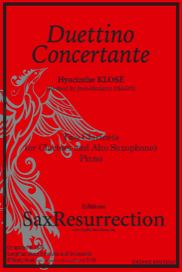
Price: €30
S.R.9: Hyacinthe KLOSÉ: Duettino Concertante (Two Clarinets -or Clarinet and Alto Saxophone- and Piano).
Composed in 1876.
Longtime: about 9 minutes and 54 seconds.
Difficulty level (from 1 -easiest- to 14 -very difficult-): 9-10
Main technical and performance skills: expressive phrasing, intonation, timbre melting, rhythmic accuracy and coordination, varied articulations and dynamics, and cadenza imagination.
Composed in 1876.
Longtime: about 9 minutes and 54 seconds.
Difficulty level (from 1 -easiest- to 14 -very difficult-): 9-10
Main technical and performance skills: expressive phrasing, intonation, timbre melting, rhythmic accuracy and coordination, varied articulations and dynamics, and cadenza imagination.
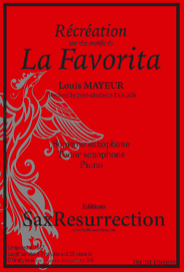
Price: €18
S.R.10: Louis MAYEUR: La Favorite (Soprano saxophone, Tenor saxophone and Piano).
Composed in 1877.
Longtime: about 7 minutes and 25 seconds.
Difficulty level (from 1 -easiest- to 14 -very difficult-): 5-6
Main technical and performance skills: expressive phrasing, opera singing reference, intonation and varied dynamics.
Composed in 1877.
Longtime: about 7 minutes and 25 seconds.
Difficulty level (from 1 -easiest- to 14 -very difficult-): 5-6
Main technical and performance skills: expressive phrasing, opera singing reference, intonation and varied dynamics.
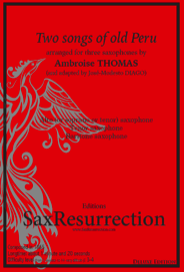
Price: €8
S.R.11: Ambroise THOMAS: Two songs of old Peru (Alto -or soprano or tenor- saxophone, Tenor saxophone and Baritone saxophone).
Composed in 1865
Longtime: about 1 minute and 20 seconds
Difficulty level (from 1 -easiest- to 14 -very difficult-): 3-4
Main technical and performance skills: sustained air, intonation and voices balance.
Composed in 1865
Longtime: about 1 minute and 20 seconds
Difficulty level (from 1 -easiest- to 14 -very difficult-): 3-4
Main technical and performance skills: sustained air, intonation and voices balance.
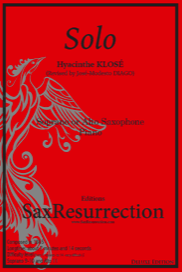
Price: €20
S.R.12: Hyacinthe KLOSÉ: Solo (Soprano or Alto Saxophone and Piano).
Composed in 1865.
Longtime: about 7 minutes and 14 seconds.
Difficulty level (from 1 -easiest- to 14 -very difficult-): Soprano 9-10 and Alto 11
Main technical and performance skills: expressive phrasing, intonation, ease and agility playing, varied articulations and dynamics, vibrato recommended, rhythm and beat accuracy and Cadenza imagination. Altissimo register (for Alto Saxophone).
Composed in 1865.
Longtime: about 7 minutes and 14 seconds.
Difficulty level (from 1 -easiest- to 14 -very difficult-): Soprano 9-10 and Alto 11
Main technical and performance skills: expressive phrasing, intonation, ease and agility playing, varied articulations and dynamics, vibrato recommended, rhythm and beat accuracy and Cadenza imagination. Altissimo register (for Alto Saxophone).
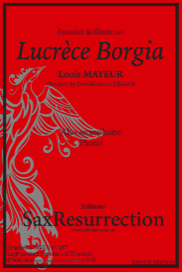
Price: €18
S.R.13: Louis MAYEUR: Lucrèce Borgia (Alto saxophone and Piano).
Composed in 1877(?) or 1897.
Longtime: about 7 minutes and 20 seconds.
Difficulty level (from 1 -easiest- to 14 -very difficult-): 9-10
Main technical and performance skills: expressive phrasing, opera singing reference, intonation, ease and agility playing, varied articulations and dynamics, cadenza imagination.
Composed in 1877(?) or 1897.
Longtime: about 7 minutes and 20 seconds.
Difficulty level (from 1 -easiest- to 14 -very difficult-): 9-10
Main technical and performance skills: expressive phrasing, opera singing reference, intonation, ease and agility playing, varied articulations and dynamics, cadenza imagination.
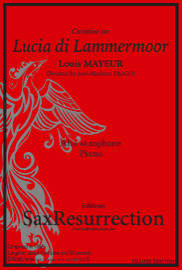
Price: €18
S.R.14: Louis MAYEUR: Lucia di Lammermoor (Alto saxophone and Piano).
Composed in 1869.
Longtime: about 6 minutes and 50 seconds.
Difficulty level (from 1 -easiest- to 14 -very difficult-): 8
Main technical and performance skills: expressive phrasing, opera singing reference, intonation, varied articulations and dynamics, cadenza imagination, and circular breathing, if possible.
Composed in 1869.
Longtime: about 6 minutes and 50 seconds.
Difficulty level (from 1 -easiest- to 14 -very difficult-): 8
Main technical and performance skills: expressive phrasing, opera singing reference, intonation, varied articulations and dynamics, cadenza imagination, and circular breathing, if possible.
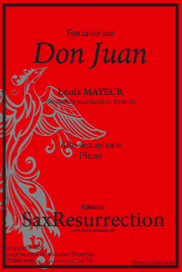
Price: €18
S.R.15: Louis MAYEUR: Don Juan (Alto saxophone and Piano).
Composed in 1872.
Longtime: about 16 minutes and 50 seconds.
Difficulty level (from 1 -easiest- to 14 -very difficult-): 7-8
Main technical and performance skills: expressive phrasing, opera singing reference, intonation, varied dynamics, ease and agility playing, and sustained air.
Composed in 1872.
Longtime: about 16 minutes and 50 seconds.
Difficulty level (from 1 -easiest- to 14 -very difficult-): 7-8
Main technical and performance skills: expressive phrasing, opera singing reference, intonation, varied dynamics, ease and agility playing, and sustained air.
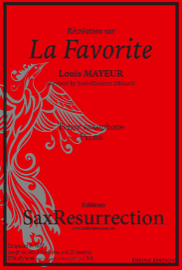
Price: €15
S.R.16: Louis MAYEUR: La Favorite (Tenor saxophone and Piano).
Composed in 1877.
Longtime: about 5 minutes and 20 seconds.
Difficulty level (from 1 -easiest- to 14 -very difficult-): 5-6
Main technical and performance skills: expressive phrasing, opera singing reference, and varied dynamics.
Composed in 1877.
Longtime: about 5 minutes and 20 seconds.
Difficulty level (from 1 -easiest- to 14 -very difficult-): 5-6
Main technical and performance skills: expressive phrasing, opera singing reference, and varied dynamics.
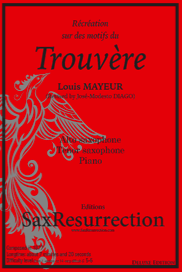
Price: €15
S.R.17: Louis MAYEUR: Le Trouvère (Alto saxophone, Tenor saxophone and Piano).
Composed in 1877.
Longtime: about 7 minutes and 20 seconds.
Difficulty level (from 1 -easiest- to 14 -very difficult-): 5-6
Main technical and performance skills: expressive phrasing, opera singing reference, intonation and varied dynamics.
Composed in 1877.
Longtime: about 7 minutes and 20 seconds.
Difficulty level (from 1 -easiest- to 14 -very difficult-): 5-6
Main technical and performance skills: expressive phrasing, opera singing reference, intonation and varied dynamics.
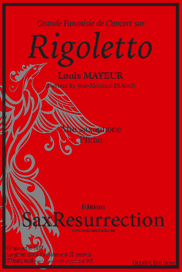
Price: €18
S.R.18: Louis MAYEUR: Rigoletto (Alto saxophone and Piano).
Composed in 1877.
Longtime: about 9 minutes and 25 seconds.
Difficulty level (from 1 -easiest- to 14 -very difficult-): 8-9
Main technical and performance skills: expressive phrasing, opera singing reference, intonation, cadenza imagination, varied articulations and dynamics, rhythm and beat accuracy, and ease and agility playing.
Composed in 1877.
Longtime: about 9 minutes and 25 seconds.
Difficulty level (from 1 -easiest- to 14 -very difficult-): 8-9
Main technical and performance skills: expressive phrasing, opera singing reference, intonation, cadenza imagination, varied articulations and dynamics, rhythm and beat accuracy, and ease and agility playing.